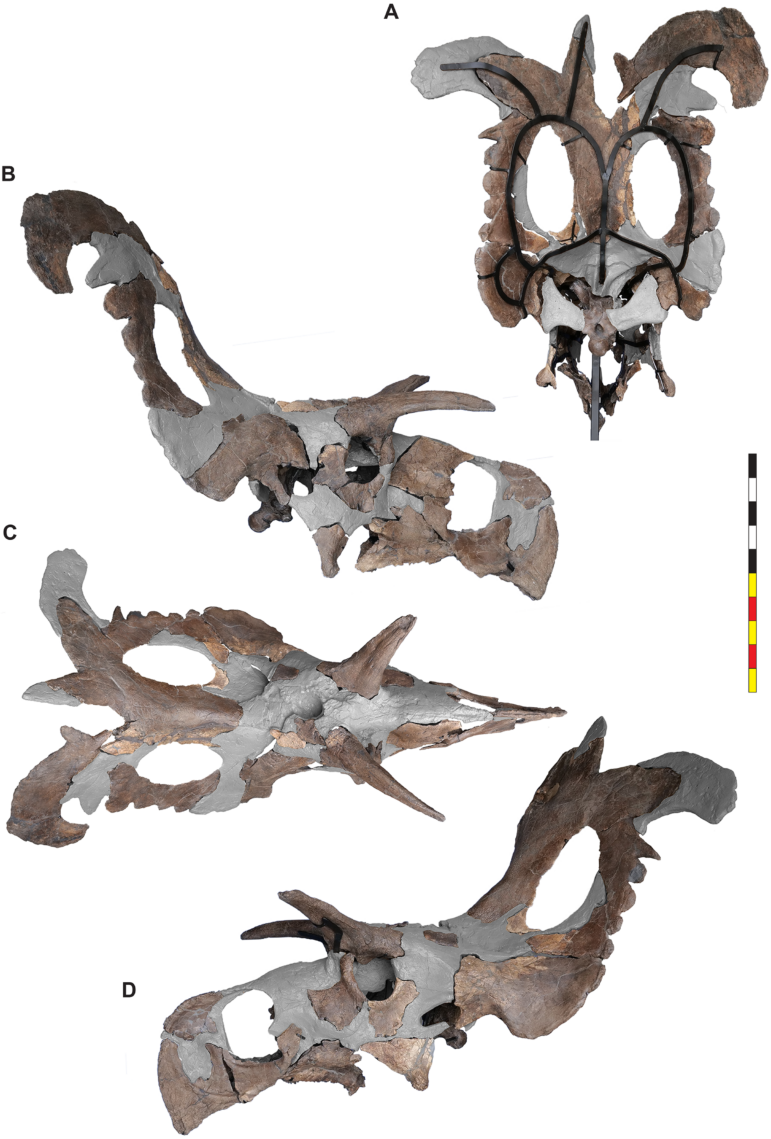
Rudyard, MONTANA – This week, scientists announced the discovery of a potential new species of dinosaur based off of a fossilized skull found in Montana in 2019. The dinosaur would have lived some 78 million years ago, according to a paper published in the journal PeerJ, a time when what is today the arid borderland between Montana and Alberta, Canada, lay on the coastline of a vast inland sea.
The dinosaur was a four-legged herbivore, part of the group of horned dinosaurs called the ceratopsians, whose most famous member is the three-horned triceratops. But examination of the particular features of this fossil’s skull have led researchers to categorize the dinosaur as a new species in the family, one they have given a name sure to interest any Pagan with a passion for paleotontology – Lokiceratops rangiformis, a named taken from the Norse god.

Photographs of the Lokiceratops rangiformis skull. A) Mounted skull in posterior view. (B) Mounted skull in right lateral view. (C) Mounted skull in dorsal view. (D) Mounted skull in left lateral view. Areas in gray are reconstructed. [Marcus Donivan for PeerJ]
The name pays tribute to both the fossil’s excavation and to its peculiar shape. The decision to name the fossil after a Scandinavian deity came after it was purchased by the Museum of Evolution in Maribo, Denmark, where it will be on display for visitors from around the world. “[The museum] saved it by purchasing it, so now it’s available in perpetuity for scientists to look at it,” Joseph Sertich, one of the authors of the paper, told the New York Times. “We couldn’t write a paper on a fossil sitting in a rich person’s living room and being treated as art.”
Secondly, the dinosaur possesses unusual horns that curve in a way similar to Loki’s helmet – at least the now-famous version of Loki from the Marvel comics and films. The named Lokiceratops is Latin for “Loki’s horned face,” while rangiformis references a type of caribou with asymmetrical antlers, similar to Lokiceratops‘s asymmetrical curved horns. These horns are each two feet long, the largest frill horns observed on a dinosaur so far.
Why did Lokiceratops have such distinctive horns? “The horns and frill were most likely used for display in Lokiceratops and other horned dinosaurs,” Sertich told Reuters. “These displays could have been used to intimidate rivals, attract mates or recognize members of the same species.”

Nat Archaic cosplaying as Loki [greyloch, Flickr, CC 2.0]
Lokiceratops would represent the fifth species of horned dinosaur found in the region around Montana, a stunning amount of local diversity. “Really, this is like finding five species of elephants living on the same savanna in Kenya,” said Mark Loewen, a paleontologist at the University of Utah and one of the lead authors of the study.
At the point in the Cretaceous period when Lokiceratops would have lived, there appear to have been many different species of similar dinosaurs, each linked to a relatively small geographic area, indicating rapid evolutionary change at that time.
“This is the first time five ceratopsians have been recognized from the same ecosystem,” says Sertich. “For over a century, it was believed that no more than two could co-exist in the same ecosystem, but emerging evidence here in Montana, and elsewhere in southern Laramidia, is revealing unexpected richness.”
By the end of the period, more than 10 million years later, centrosaurines – the branch of the ceratopsians that Lokiceratops belongs to – had died out and chasmosaurines like triceratops were found all across the North American continent.

Lokiceratops rangiformis silhouette [Mark Loewen, CC 4.0]
Not all scientists agree that Lokiceratops reflects a new species, however. Denver Fowler, a paleontologist at the Dickinson Museum in North Dakota, told the Times that many of the features of the Lokiceratops fossil could be explained as belonging to an long-lived Medusaceratops – another centrosaurine named for a mythological character. “That would be the more conservative explanation,” Fowler said. If so, that would indicate more variation within fewer overall species.
“[The Lokiceratops fossil is] a spectacular specimen, and it absolutely needs to be described,” Fowler added. “It really helps us to flesh out the fauna.”
The question of what classification Lokiceratops belongs to would be no surprise to its namesake, of course – the mythological Loki spends much of his time dancing between the categories of jötunn and áss himself. One hopes Lokiceratops had a better relationship with its family, though.
The Wild Hunt is not responsible for links to external content.
To join a conversation on this post:
Visit our The Wild Hunt subreddit! Point your favorite browser to https://www.reddit.com/r/The_Wild_Hunt_News/, then click “JOIN”. Make sure to click the bell, too, to be notified of new articles posted to our subreddit.